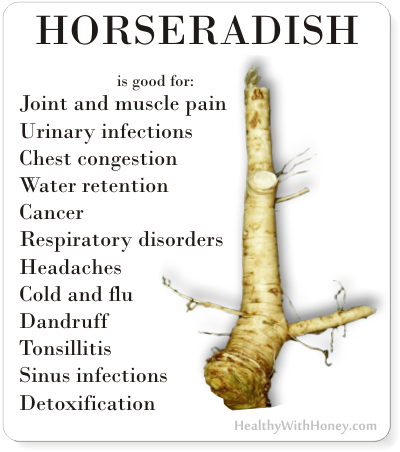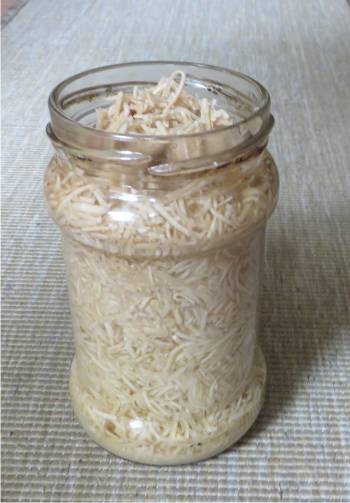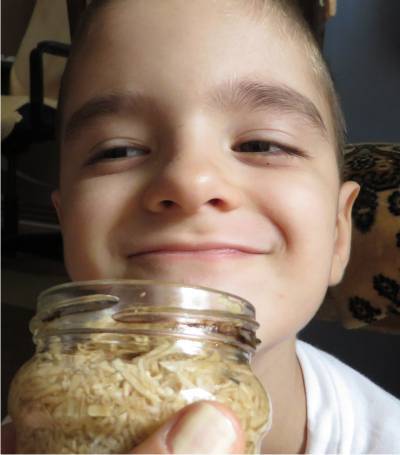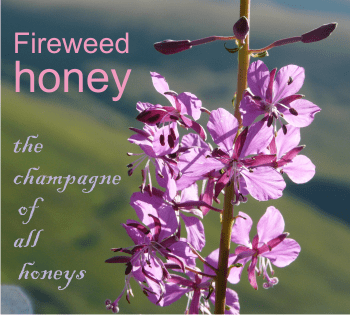Have you ever wondered how to lose weight fast and naturally? Of course you have and of course you’ve tried a lot. Could honey help you lose weight? Not alone, that’s for sure. If you haven’t given up yet, try a natural and cheap product, like horseradish. You’ll see here some of the horseradish benefits for health.
It is possible to not lose weight after it but at least you will be healthier.
And who knows for sure? This plant could be exactly what you need.
There have been lots of research, studies and clinical trials on the effects of honey alone on our weight. You’ll find details here: Can honey help you lose weight? The truth, please!
But there can be some combinations, which include raw honey, that can really help us lose weight.
Here are 7 recipes known to help in losing weight.
1. Horseradish, lemon, honey
The recipe is recommended by a famous Russian phyto-therapeutist, Dr. Irina Stefanovska, who says that her revolutionary remedy can help women melt a centimeter in the waist in a day! (I don’t know why she refers only to women. None of the ingredients have particular connections with female hormones. Or, perhaps in Russia there are more obese women than men, I wouldn’t know!)
Why am I tempted to believe she is not one of the million scams in the online wildlife?
Because she is not selling us anything! Scams have only one purpose in mind: to make money no matter how. This doctor did not make pills, mixing the three ingredients, though I imagine it would have been easy. Which is why I believe that no matter if the recipe works or not, her intentions were good. Anyway, if you try it, please let me know.
Ingredients:
– 125 g of horseradish
– 3 raw lemons
– 3 tablespoons honey
Preparation:
You’ll need a blender for this. Slice the horseradish, cut the lemons and remove the seeds, add honey and blend them well. Place the mixture in a glass jar and store it in the refrigerator. That simple.
Take one tablespoon twice a day with a meal.
The Russian doctor tells that there will be visible results within 3 weeks. And besides looking more slimmer, we’ll also have an improved brain function, memory, hearing and vision.
If not, well, at least we didn’t waist money on expensive pills.
Is horseradish that good for our health?
That and more!
Horseradish (Armoracia rusticana, syn. Cochlearia armoracia) is a perennial plant of the Brassicaceae family (which also includes mustard, wasabi, broccoli, and cabbage).
What’s with the name?
It was first attested in 1590s and it combines the 2 words “horse” and “radish”. Horse was used in a figurative sense meaning strong or coarse. And radish, well it’s a root growing like a radish in the ground. But these are just assumptions, nobody knows for sure. It may just as well mean that this radish makes you strong as a horse!
From this plant we use only the root, today mostly as a spice, but in the ancient times was also used as a medicine.
A horseradish is worth its weight in gold! – said the Greek Delphic Oracle
The root appears everywhere. The early Greek healers were using horseradish as a rub for low back pain. Then it has a long tradition to represent “bitter” in Jewish Seder meals. Also suggested as an aphrodisiac in both Egypt and Greece. It is used as a condiment first in Germany, Scandinavia, and Britain. Then it was introduced to North America during European colonialization.
But let’s ignore its uses as a condiment and stay on its medical uses.
Horseradish benefits for health
 Horseradish has been reported to have antimicrobial, spasmolytic, cytotoxic, antiseptic, diuretic, stimulant, and antioxidant properties.
Horseradish has been reported to have antimicrobial, spasmolytic, cytotoxic, antiseptic, diuretic, stimulant, and antioxidant properties.
The picture lists a series of conditions that can be treated with horseradish. But this is not simply a list. Not another list of diseases which can be miraculously treated with one plant. There are 24868 studies published on ncbi.nlm.nih.gov/pubmed, which means this plant has really got our attention.
It contains:
– calcium, potassium, magnesium and phosphorus, as some of the most prominent minerals, fibers and vitamin C,
– volatile oils (such as mustard oil), which are anti-viral and can help fight infection.
– Glucosinolates, which are found to affect the metabolism of hormones (see this study). Among them there is Sinigrin, which is found to relive the symptoms of water retention, due to its stimulating effect on the blood capillaries. (see this study). Organosulfuric, chemoprotective glucosinolates, are also found in broccoli sprouts, but in horseradish they are 10 times more!
– anti-carcinogens like allyl isothiocyanate (AITC) which demonstrated 90 percent absorption when ingested. Horseradish’s pungent flavour is primarily caused by this AITC. The compound is produced from the hydrolysis of sinigrin by the enzyme myrosinase. (more details here)
Due to AITC, horseradish has very strong antimicrobial properties, much more inhibitory than sodium benzoate. Compared to this one, AITC can diffuse more rapidly through at any pH and stops the cell grouth. All the studies suggest that AITC from the horseradish is better suited to be used as a food preservative than sodium benzoate (which gives side effects like hyperactivity and behavioral problems).
AITC was between 6 and 21 times more inhibitory to the growth of Gram-negative E. coli than benzoate, and 3 to 45 times more inhibitory to Staphylococcus aureus. (see the study here).
Kills cancer cells and prevents their formation.
It has been said that horseradish has an oddly sweet heat that warms you to your core. And it may all be in the heat! The Scoville Scale which typically measures the heat of peppers, is based on capsaicin content. But in horseradish, it’s from allyl isothiocyanate (AITC), a compound that is much more than just a heat- and flavor-loaded compound. Scientists said AITC may be useful for bladder cancer prevention, among other malignancies.
According to Yuesheng Zhang in the 2010 study, AITC may be most effective in the bladder as a cancer chemopreventive compound. “Presents many desirable attributes of a cancer chemopreventive agent, including extremely high bioavailability after oral administration, rapid uptake by cells, microbicidal activity against a wide spectrum of pathogens, significantly higher toxicity in malignant cell than in normal cells, its ability to rapidly induce cancer cell death regardless of its tissue origin”.
It is very effective against sinus infections
Mainly because it helps rid your body of mucus in the sinuses, where bacterial infections often start. Once your nostrils are introduced to the strong kick of horseradish, the mucus often can’t help but begin flowing, which is the signal that the infection is on its way out of your body.
 Here is “The Sinus Plumber” – An old recommended recipe to clear mucus from your nose, as well as congestion from your chest.
Here is “The Sinus Plumber” – An old recommended recipe to clear mucus from your nose, as well as congestion from your chest.
An 8- to 12-inch-long chunk of horseradish root;
1 Tbsp. apple cider vinegar;
2 Tbsp. water;
a pinch of salt (to taste)
Stir the ingredients together in a small glass jar, which can be stored in the
refrigerator for four to five weeks. Eat one-half to 1 tsp. two to three times a day for as long as it takes for your congestion to begin clearing up.
I personally use a similar combination whenever my son has a cold. I dare say it works better than the drops my doctor recommends us for the nose. True, it doesn’t have an instant effect, like the synthetic drops have, but he is cured more rapidly.
I put grated horseradish and vinegar in a glass jar and just leave it like that. I don’t even refrigerate it. And whenever I remember I put my son to sniff it. No eating, only inhaling that smell.
Contraindications:
Don’t take horseradish if you have gastric ulcer or thyroid problems. Also take it with cautions if you have IBS or hyperacid gastritis. Do not abuse it! It’s powerful and taking too much of it can cause digestive and nervous problems.
2. Honey and cinnamon
Pour a glass of hot water over a teaspoon of cinnamon. Make sure it’s real cinnamon. Cover and let it stay for half an hour. Strain and add a teaspoon of raw honey.
Drink this tea every morning, half an hour before breakfast.
read more on: Cinnamon Honey Benefits
3. Honey, garlic and apple cider vinegar
Mix 16 gloves of garlic, finely chopped, with 500 g of raw honey and add 1 liter of apple cider vinegar (bio or home made). Put all these ingredients in a glass jar, seal it well and leave it in a dry cool place for 3 days.
Take one tablespoon of this mixture in the morning, half an hour before breakfast and one in the evening, half of hour before dinner, for a month.
here is an interesting review: Lemon-Garlic-Honey for colds and immunity
4. Honey with orange, grapefruit and lemon
Mix the juice of a freshly squeezed orange, grapefruit and half a lemon with one teaspoon of raw honey.
This cocktail has to be drunk fresh, every day, in the morning and in the afternoon, before meals, for a month.
5. Tea with lemon and honey
Squeeze one organic lemon into a glass. Cut the rest of the lemon (the squeezed fruit) in small pieces and place them in 300 ml of water, which will be boiled for 15 minutes, in a covered pot. Let this tea to cool and then pour the lemon juice over it. Add one tablespoon of honey.
Drink the tea every morning, half an hour before breakfast, for a month. Then have a pause of 2 weeks and then do the treatment again.
6. Horseradish, lemon, cinnamon, ginger, honey
All these make a syrup that accelerates the process of losing weight, shrink the volume in the waist, get rid of excess water in the body. Here it is:
- 130 g fresh horseradish
- 3 organic lemons
- 4 tablespoons honey
- 2 teaspoons cinnamon
- 2 cm fresh ginger root
Peel and grate the ginger and the horseradish. Add the lemons, unpeeled, if they are organic, if not, drain only the juice only. Add cinnamon and honey. Mix them well in a blender and place in a clean jar, close it and place it in the refrigerator.
After 3 weeks, take one spoon of the syrup in the morning on an empty stomach and at night, before bed.
7. ACV, garlic, onion, pepper, ginger, horseradish, turmeric
That’s another recipe that mixes all the known powerful anti-immflamator, antimicrobial and antioxidant plants that are highly recommended in our online world, for our overall health. It is said to prevent all illnesses and provide much energy. (Keep in mind that there haven’t been any studies done on this combination and we don’t know for sure how they behave together.)
- 700 ml apple cider vinegar
- ¼ cup finely chopped garlic
- ¼ cup finely chopped caramelized onions
- 2 fresh peppers
- ¼ cup grated ginger
- 2 tablespoons grated horseradish
- 2 tablespoons turmeric
- raw honey at taste
Place all ingredients (except for the apple cider vinegar) in a large bowl. Blend them and place the mixture in a jar, then add the apple cider vinegar. Close the jar tightly and shake well. The jar should be filled only two- thirds with the mixture, and the rest with apple cider vinegar.
Keep the jar in a dry and cool place for two weeks. Mix some honey in it, to make it more palatable.
Take one tablespoon a day and your immune system will significantly improve. However, make a break after you finish the jar, as the cure is quite strong.
Where can I buy horseradish from?
At your locals, of course. Or at the market.
Amazon also sells it in its natural raw form, found in Garden & Outdoor department. It is the real thing, ready to plant. Here is an example: Horseradish Roots Natural Organic Ready to Plant 1 Pound By Growerssolution.
************************
************************
References and picture references:
– http://articles.mercola.com/sites/articles/archive/2016/05/30/horseradish-benefits.aspx
– http://www.naturalcuresandhomeremedies.com/the-recipe-of-the-famous-russian-herbalist-is-a-hit-all-around-the-world-you-can-reduce-10-centimeters-in-the-waist-in-only-10-days/
– http://www.naturalcuresandhomeremedies.com/here-is-how-to-prepare-amazing-immunity-bomb-at-home-it-will-prevent-all-illnesses-and-provide-much-energy/
– http://www.naturalcuresandhomeremedies.com/amazing-syrup-that-burns-belly-fat-in-only-3-weeks/ (picture of the jar)
– https://en.wikipedia.org/wiki/Horseradish
– root of horseradish – picture credit Frank Vincentz, published under CC via wikimedia commons.
– horseradish roots at the market – picture credit Amanda Slater, published under CC via wikimedia commons.



